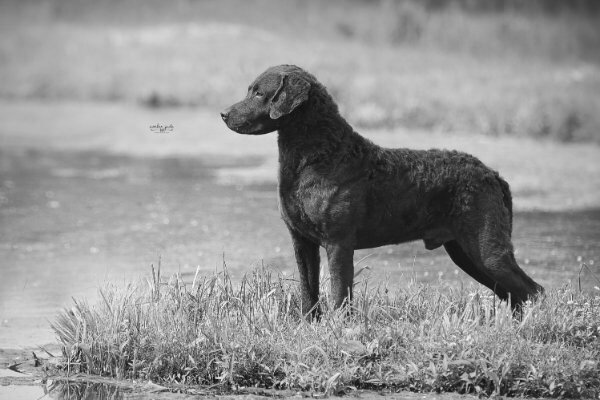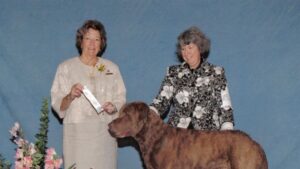
Judging the Chesapeake Bay Retriever
Explore the distinctive traits and judging standards of the Chesapeake Bay Retriever, focusing on their unique structure, movement, and coat.
Home » Meet The Breeds » Chesapeake Bay Retriever





The Chesapeake Bay Retriever, often referred to as the “Chessie,” is one of the most highly regarded water dogs in the United States and elsewhere. Originating from the shores of Maryland’s Chesapeake Bay, this breed is celebrated for its exceptional stamina, intelligence, and loyalty. With a waterproof coat and unparalleled determination, the Chessie is not only a dedicated worker but also a loving family companion. Known for its distinctive “Chessie Smile,” these retrievers carry a rich history of serving hunters and families alike.
Sporting
21-26 Inches
55-80 Pounds
10-13 Years
| Country of Origin | United States |
|---|---|
| Bred For | Retrieving Birds, Companionship |
| Known For | Quiet Good Sense, Intelligence, Protectiveness, Love for Water |
| Popularity | Moderate |
| Temperament | Bright, Affectionate, Sensitive |
| Activities | Hunting, Running, Hiking, Conformation Shows, Dog Sports |
The Chesapeake Bay Retriever traces its origins to the shores of the Chesapeake Bay, stretching between Maryland and Virginia. The breed’s unique history is a tale of shipwrecks, resilience, and a deep-rooted connection to the water.
In the early 19th century, two puppies, thought to be Newfoundland dogs, were rescued from a shipwrecked vessel off the coast of Maryland. Named “Sailor” and “Canton,” these dogs quickly earned a reputation for their unparalleled retrieving abilities, especially in water. Local waterfowl hunters, impressed by the dogs’ endurance, keen sense of smell, and love for water, began integrating them into their hunting routines. Through selective breeding with local hounds, setters, and other retrievers, the distinct characteristics of the modern Chesapeake Bay Retriever began to emerge.
The breed was officially recognized by the American Kennel Club (AKC) in 1878, making it one of the oldest American breeds. Over time, the Chesapeake became renowned not just as an exceptional waterfowl retriever but also for its loyalty, intelligence, and naturally protective nature.
The Federation Cynologique Internationale (FCI) and The Royal Kennel Club (UK) also recognize the Chessie, further cementing the breed’s status as a distinguished purebred on the global stage.
Today, while the Chesapeake Bay Retriever remains a favorite among hunters, but it is also cherished as a family companion, protective guard dog, and an active participant in many dog sports and field events.
An adult male Chesapeake Bay Retriever usually stands between 23 and 26 inches tall at the shoulder, while mature females range from 21 to 24 inches.
In terms of weight, males generally range between 65 and 80 pounds, with females being generally lighter at 55 to 70 pounds. These figures can vary based on individual factors, but they do reflect the breed’s typically robust and athletic build.
The Chesapeake Bay Retriever is a well-proportioned dog, with a body length that is slightly longer than its height at the withers. The breed presents a medium-to-large figure, emphasizing both strength and endurance. The Chessie’s substance is solid without appearing cumbersome, supporting an agile retriever that remains ideal for waterwork and capable over challenging terrain.
Texture: The coat of the Chesapeake Bay Retriever is distinctive and serves a functional purpose. It consists of a dense, waterproof undercoat, which provides insulation from the cold, and a short, harsh outer coat that offers protection against brambles and brush. The coat’s resilience is evident in its ability to shed water easily, helping the Chessie to excel in its water-retrieving duties.
| Standard Color | |
|---|---|
| Brown | ee |
| Dark Brown | ee |
| Dark Deadgrass | ee |
| Deadgrass | ee |
| Light Brown | ee |
| Light Deadgrass | ee |
| Sedge | ee |
| Tan | ee |
Markings: Small white spots are permitted on the breast, belly, toes, or the backs of the feet (immediately above the large pad).
A Note About Color: Solid-colored dogs are preferred, although masking on the top skull, light and dark striping, and saddle markings are acceptable. Deeper coloration on the ears and muzzle is acceptable. Black hairs, or white hairs on any part of the body not specified, are unacceptable.
The head of the Chesapeake Bay Retriever is one of its defining features, demonstrating the breed’s strength and its character.
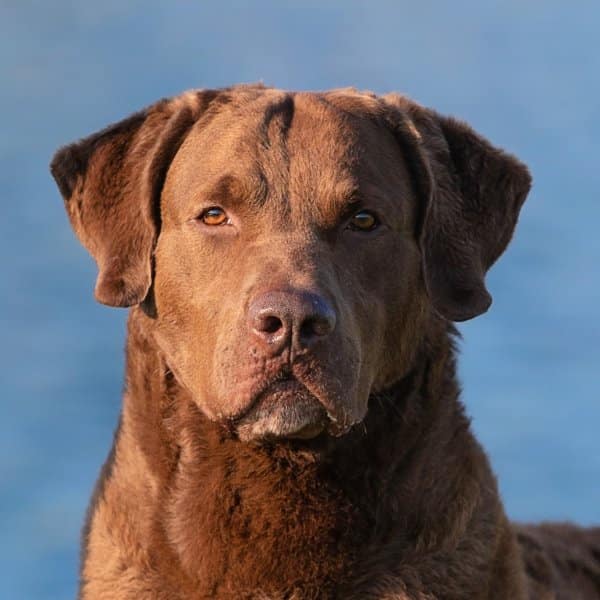
The tail of the Chesapeake Bay Retriever serves as a rudder in the water. It is of medium length, either straight or gently curved but never curled over the back or to the side. As an extension of the hindquarters, which can be as high as or a trifle higher than the shoulders, the tail is broad at the base and tapers towards the end. The coat on the tail is dense and water-resistant, similar to that of the body but slightly shorter. It should not be feathered.
Bringing a Chesapeake Bay Retriever into the home isn’t just about acquiring a pet; it’s about adding a devoted companion and a hard-working member to the family. The breed’s love for water, combined with its history as an esteemed hunter, makes the Chessie a unique breed that requires consistent care and proper management. While this retriever can be a great choice as a family companion, it’s crucial to understand its specific needs and its unique characteristics in order to ensure a harmonious home life.
The health and well-being of a Chesapeake Bay Retriever are important for anyone who cares about the breed. Generally, Chessies are robust and hardy, benefitting from the breed’s origin as a waterfowl retriever. Their active lifestyle certainly keeps them fit, but like any breed or mixed breed, individuals can encounter specific health concerns.
Lifespan: On average, a Chesapeake Bay Retriever can expect to live between 10 and 13 years. This lifespan can be influenced by various factors, including genetics, diet, exercise, and regular veterinary care.
Chesapeake Bay Retrievers, despite their overall ruggedness, are not immune to certain health issues. Owners should be aware of the following common concerns:
Regular veterinary check-ups play a pivotal role in early detection and management of these and other conditions. Keeping a close eye on a dog’s health and ensuring it receives preventative care can make a significant difference in the quality of life. In addition to regular vet visits, potential owners should consider genetic testing and make sure their puppies come from reputable breeders who test the parents for inheritable health issues.
At the heart of the Chesapeake Bay Retriever lies a harmonious blend of dedication, intelligence, and loyalty. This breed, known for its strong-willed nature, can pose a challenge for novice dog owners. While Chessies are undoubtedly eager to please, understanding their temperament and responding with consistent guidance is key to fostering a meaningful bond.
Chessies have a sensitive side. They thrive on positive reinforcement and can often become withdrawn or even stubborn when faced with harsh treatment. Despite their deep attachment to their families, they have an innate ability to tolerate periods of solitude. However, like most breeds, they don’t take well to prolonged isolation, which can lead to feelings of boredom and spur potentially destructive behavior.
When it comes to their interaction with other dogs, early socialization is of utmost importance for a Chessie. The breed’s territorial nature means that without appropriate introductions during the formative puppy months, a dog might develop aggressive tendencies, especially toward dogs of the same sex. However, many Chesapeake Bay Retrievers live harmoniously with other pets when well-socialized and brought up in an environment that fosters a respect for boundaries.
Families with young children may find that the Chessie often forms strong bonds with younger family members. While they are generally gentle and protective, interactions should always be supervised to ensure the safety of both the children and the dog.
One of the defining traits of the Chesapeake Bay Retriever is its reserved demeanor towards strangers. The breed’s natural inclination is to be protective of the family makes this dog an excellent watchdog. This inherent trait means newcomers might need to exercise patience, giving the Chessie ample time to warm up to unfamiliar faces.
Feeding a Chesapeake Bay Retriever requires an understanding of both the dog’s activity level and its unique nutritional needs. Being a breed with origins in demanding physical work, the Chesapeake Bay Retriever often has a higher energy requirement than some other breeds.
For puppies, it’s essential to provide a balanced diet that supports their rapid growth. Foods specifically formulated for large-breed puppies can be a good choice, ensuring they receive the right nutrients without promoting overly fast growth, which could strain their developing skeletal system.
As the Chesapeake Bay Retriever transitions to adulthood, the dietary needs will change. Active adult dogs will require a diet rich in protein and calories to support their energy levels. On average, a Chesapeake Bay Retriever might consume between 2.5 to 3.5 cups of high-quality dry dog food daily, split into two meals. However, the exact amount will vary depending on a dog’s weight, age, metabolism, and activity level.
In terms of feeding charts, while they provide a useful guideline, it’s crucial to monitor the dog’s weight and adjust portion sizes based on activity levels and body condition. Overfeeding can lead to obesity, a concern that can exacerbate potential health issues in the breed.
Senior Chesapeake Bay Retrievers might see a decrease in activity levels, necessitating a reduction in caloric intake. Foods tailored for senior dogs can help to address their changing nutritional needs, ensuring they maintain a healthy weight in their golden years.
In any life stage, providing fresh water at all times is essential. Moreover, occasional treats can be a delightful addition, but they should be given in moderation to avoid excess weight gain.
Training a Chesapeake Bay Retriever demands an understanding of this breed’s spirited and independent nature. Famed for their intelligence and determination, Chessies can excel in training sessions that employ consistency, positivity, and firmness.
The innate intelligence of the Chesapeake Bay Retriever can be both a gift and a challenge. While these dogs have the capacity to pick up commands quickly, their independent streak can sometimes make them appear stubborn. They are not always immediately compliant, often preferring to weigh the benefits of obeying a command. This is why it’s crucial for trainers to be consistent and firm without being overly harsh.
Chessies often respond best to training methods rooted in positive reinforcement. Treats, praise, and play can motivate them effectively. Due to their sensitivity, negative or punishment-based techniques can lead to a withdrawn or unresponsive dog.
Regarding their vocal nature, while they are not known to be excessive barkers, Chessies will alert their family to unfamiliar sounds or possible intruders. Early training can help to modulate this behavior, ensuring they bark when necessary but can also be quieted on command.
Their intelligence and drive make the Chesapeake Bay Retriever an excellent candidate for advanced Obedience and other Dog Sports. However, these traits come with a double-edged sword; the breed’s potential for wanderlust and predation. Proper recall training and a secure environment are essential for any Chessie, ensuring it won’t chase after interesting scents or smaller animals.
Understanding and addressing the exercise needs of a Chesapeake Bay Retriever is vital for its well-being, both mentally and physically. These dogs carry with them a rich heritage of work, particularly in retrieving from water, which has fostered a breed with robust energy and a strong drive.
| Energy Level | High |
|---|---|
| Exercise Requirements | 40 Minutes/Day, Daily Walks, Weekly Swimming, Regular Exercise, Playing with Another Dog, Mental Stimulation |
The Chesapeake Bay Retriever’s exercise regimen should be reflective of its innate high energy and stamina. This breed is not the type of dog to be content with just a short walk around the block. Instead, Chessies thrive on more vigorous activities like running, swimming, and playing fetch. Incorporating regular play sessions into their daily routine not only helps in burning off their energy, it also strengthens the bond between the dog and its favorite person.
The intensity of their exercise needs cannot be overstated. Without adequate physical stimulation, Chessies can become restless, leading to undesirable behaviors like digging, barking, or even chewing. Moreover, exercise is not just about tending to their physical health; it also plays a pivotal role in their mental stimulation. Activities that challenge their intelligence, such as Agility training or Scent Work, can be highly beneficial for this breed.
Their playfulness is another characteristic that can be channeled positively. Engaging Chesapeake Bay Retrievers in games that mimic their natural retrieving instincts, like fetch or even water-based activities, can be particularly rewarding for them.
Grooming a Chesapeake Bay Retriever is a balance of maintaining the dog’s unique coat without excessive interference. The Chessie’s coat, designed by nature, serves a specific purpose. It’s water-resistant, allowing this dog to perform its retrieving duties in various water conditions effectively.
| Coat Type | Thick, Short, Wooly |
|---|---|
| Grooming Requirements | Weekly Brushing, Occasional Bathing, Routine Ear Cleaning, Periodic Nail Trimming, Regular Tooth Brushing |
The Chesapeake’s coat is dense, with a fine, wooly undercoat that provides insulation, and a coarse, short outer coat that helps to repel water. While the coat is not as demanding as that of some long-haired breeds, it does have its own unique requirements. Regular brushing, about once a week, can help in removing loose hairs and keeping the coat healthy. It’s essential, however, not to over-groom this breed, as excessive brushing can strip the coat of its natural oils, diminishing its water-resistant properties.
Shedding is a natural part of Chessie’s life, particularly during the shedding seasons in spring and fall. During these times, more frequent brushing might be necessary to manage the loose hairs.
Baths for the Chesapeake Bay Retriever should be given sparingly. The natural oils in the coat make it resistant to dirt, and often, a simple rinse with water can remove any mud or debris. When baths are necessary, it’s important to use a mild dog shampoo and ensure the coat is thoroughly rinsed and dried.
Other grooming essentials include regular checks and cleaning of the ears, nail trimming, and dental care. Like all breeds, regular dental check-ups and at-home tooth brushing can help to prevent dental diseases.
Living with a Chesapeake Bay Retriever offers a unique and rewarding experience, punctuated by the loyalty, intelligence, and protective nature for which these dogs are greatly admired. However, ensuring a harmonious coexistence requires understanding the breed’s specific needs and temperament.
When it comes to housing, while the Chessie can adapt to apartment living, these dogs thrive best in homes with ample outdoor space. The breed’s high energy levels and love for play mean that a yard can offer the Chesapeake with an outlet to expend some of its boundless energy. If in an apartment setting, it becomes even more critical to ensure the dog is provided ample exercise and mental stimulation daily.
Weather is another consideration for the Chesapeake. The breed’s dense double coat, designed to insulate the dog from cold water, also means it can handle colder climates quite well. In contrast, hot weather can be a challenge. During warmer months, it’s crucial to provide the Chessie with shade and plenty of water, and to avoid strenuous activity during the hottest parts of the day.
The Chesapeake Bay Retriever’s natural protective instincts mean it can be wary of strangers. While this makes the breed an excellent watchdog, early socialization is essential to ensure it can differentiate between a benign visitor and a genuine threat. The Chessie’s loyalty to its family is unwavering, but this can also translate into a degree of reservation with outsiders.
The allure of a Chesapeake Bay Retriever puppy is undeniable. With its soft coat, curious eyes, and playful demeanor, these pups can melt any heart. However, bringing a Chessie puppy into the home is a commitment that requires thorough preparation and understanding of the little one’s specific needs during this crucial developmental phase.
Caring for a Chesapeake Bay Retriever puppy goes beyond ensuring it has the basics of food, water, and shelter. It’s a holistic approach that encompasses the pup’s physical, mental, and emotional needs.
Nutrition plays a pivotal role during this phase. Feeding a high-quality puppy-specific diet ensures Chessie puppies will receive all the essential nutrients for growth and development. The amount and frequency of feedings will change as they grow, but it’s vital to always follow vet-recommended guidelines and monitor every puppy for any signs of obesity or malnutrition.
Socialization is another cornerstone of puppy care. Introducing your Chesapeake puppy to various experiences, sounds, sights, people, and other animals in a positive manner can lay the foundation for a well-adjusted adult dog. This period is a window of opportunity, and making the most of it can prevent behavioral issues down the line.
Training should start early, even if it’s just the basic commands. A Chessie’s intelligence and eagerness to please make this breed a fast learner, but consistency is key. Puppy training classes can be a valuable resource, offering both the puppy and the owner the tools and techniques needed for successful training.
Healthcare is also paramount. Regular vet check-ups, vaccinations, and preventive treatments for parasites ensure that the puppy will remain healthy and protected against potential diseases.
Lastly, providing a safe environment for the Chesapeake puppy to explore, play, and rest is essential. This includes puppy-proofing the house and yard, offering plenty of toys for stimulation, and ensuring the puppy has a comfortable place to relax and sleep.
In essence, caring for a Chesapeake Bay Retriever puppy is a journey. It requires patience, knowledge, and dedication, but the joy of watching the pup grow into a loyal and loving companion makes every effort worth it.
The Chesapeake Bay Retriever, known for its athleticism, intelligence, and natural instincts, is well-suited to a variety of dog activities and sports. Engaging in these events not only showcases the breed’s capabilities, it also strengthens the bond between the dog and its handler.
The Chesapeake Bay Retriever is recognized by the world’s leading registries and kennel organizations, which categorize the breed into a specific Group based on its unique characteristics. This breed is recognized worldwide under the following Group designations:
| Organization | Group Designation |
|---|---|
| AKC (American Kennel Club) | Sporting |
| UKC (United Kennel Club) | Gun Dog |
| CKC (Canadian Kennel Club) | Sporting Dogs |
| ANKC (Australian National Kennel Council) | Gundogs |
| RKC (The Royal Kennel Club) | Gundog |
| FCI (Fédération Cynologique Internationale) | Group 8 – Retrievers – Flushing Dogs – Water Dogs ; Section 1 – Retrievers |
The ideal Chesapeake Bay Retriever is described by a Breed Standard that is approved by each of the world’s leading registries and kennel organizations. The Breed Standards for this breed may be found in the following links:
| Organization | Breed Standard |
|---|---|
| American Kennel Club | AKC Chesapeake Bay Retriever Breed Standard |
| United Kennel Club | UKC Chesapeake Bay Retriever Breed Standard |
| Canadian Kennel Club | CKC Chesapeake Bay Retriever Breed Standard |
| Australian National Kennel Council | ANKC Chesapeake Bay Retriever Breed Standard |
| The Royal Kennel Club | RKC Chesapeake Bay Retriever Breed Standard |
| Fédération Cynologique Internationale | FCI Chesapeake Bay Retriever Breed Standard |
The Chesapeake Bay Retriever, with its rich history and distinctive qualities, has garnered the admiration of countless enthusiasts over the years. As a result, several breed clubs have emerged to support, educate, and further the interests of this iconic American breed.
In the United States, the premier organization dedicated to the Chesapeake Bay Retriever is the American Chesapeake Club (ACC). Established in 1918, the ACC endeavors to preserve the breed’s written Standard, promote responsible breeding practices, and foster a community of passionate Chessie owners and breeders.
In Canada, the Chesapeake Bay Retriever Club of Canada (CBRCC) plays a pivotal role in championing the breed. This organization focuses on both breed promotion and the well-being of Chesapeake Bay Retrievers throughout the country.
In the United Kingdom, the Chesapeake Bay Retriever Club (UK) stands as a beacon for Chesapeake Bay Retriever admirers. With its dedication to the breed’s preservation and enhancement, the club offers resources, events, and a community platform for UK-based Chesapeake owners and admirers.
Membership in these clubs provides individuals with access to a wealth of information, social and competitive events, training resources, and a community of like-minded enthusiasts. For those passionate about the Chesapeake Bay Retriever, joining a breed club can be a fulfilling way to deepen the connection and commitment to these remarkable dogs.
With its unique characteristics and captivating history, the Chesapeake Bay Retriever has captured the hearts of many people who appreciate a functional companion animal. However, like all dog breeds, there are times when a Chessie finds itself in need of a new home due to various circumstances. Thankfully, dedicated rescue groups work tirelessly to ensure that these wonderful dogs find loving, forever homes.
In the US, Chesapeake Safe Harbor stands out as a notable organization. Committed to rescuing, rehabilitating, and rehoming Chesapeake Bay Retrievers, this organization extends a lifeline to Chessies in need, ensuring they receive the care and love they deserve.
In Canada, the Chesapeake Bay Retriever Relief & Rescue plays a pivotal role. The group’s commitment to rescuing and rehoming Chessies is unwavering, providing a second chance to many retrievers.
Yes, Chesapeake Bay Retrievers do shed. Like many breeds, they experience a more pronounced shedding season, usually in the spring and fall. Regular brushing can help to manage and reduce the amount of hair found around your home.
Chesapeake Bay Retrievers are known for their loyalty and protective nature. While they aren’t inherently aggressive, they can be wary of strangers and can exhibit protective behaviors if they perceive a threat. Proper socialization from a young age and consistent training are essential to ensure they are well-behaved around unfamiliar people and situations.
Absolutely! Chesapeake Bay Retrievers can make excellent family dogs. They are known for their loyalty, intelligence, and the deep bond they share with their human companions. However, due to their energetic nature and size, Chessie’s are better suited for families with older children who can interact with the dog respectfully.
No, Chesapeake Bay Retrievers are not considered hypoallergenic. Individuals with allergies should spend time around the breed before making a decision to ensure that no allergic reactions are triggered.
While they aren’t as commonly found as some other retriever breeds, Chesapeake Bay Retrievers are not exceedingly rare. They are the Official State Dog of Maryland and remain popular among hunting enthusiasts and those familiar with the breed.
Chesapeake Bay Retrievers typically have a lifespan of 10 to 13 years, though some can live longer with proper care. Regular veterinary check-ups, a balanced diet, and consistent exercise can contribute to a longer, healthier life.
Yes, Chesapeake Bay Retrievers have a natural protective instinct, making them effective watchdogs. The breed’s inherent wariness of strangers, combined with its loyalty to the family, means the Chessie can be quite vigilant in watching over the home and property. However, thoughtful training is essential to ensure the breed’s protective nature doesn’t lead to undesirable behaviors.
Chesapeake Bay Retrievers can be good with other dogs, especially if they’ve been properly socialized from a young age. However, they do have a naturally dominant and protective nature which can sometimes lead to assertiveness with unfamiliar dogs. It’s essential to introduce them to new dogs in a controlled environment and to always monitor their interactions until you’re sure of their compatibility with other animal companions.

Explore the distinctive traits and judging standards of the Chesapeake Bay Retriever, focusing on their unique structure, movement, and coat.
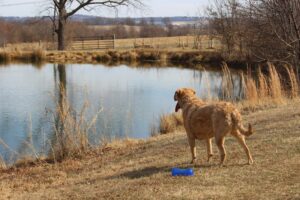
Chesapeake Bay Retrievers: DQ for Dewclaws? The current situation in countries that have laws forbidding the removal of dewclaws (front and rear).

Maria Okolita is the breeder behind Three Horses Chesapeakes. Read about the kennel’s beginnings, puppies, and much more!
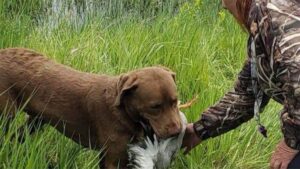
Cat Martini-Rashid is the breeder behind Sleepy Hollow Chesapeakes. Read about the kennel’s beginnings, puppies, and much more!

Dyane Baldwin is the breeder behind Pond Hollow Chesapeakes. Read about the kennel’s beginnings, the dogs, see photos, and more!
The best way to ensure a long and happy relationship with a purebred dog is to purchase one from a responsible breeder. Not sure where to begin?
Contact the National Parent Club’s Breeder Referral Program, which is listed on the AKC Breeder Referral Contacts page.
